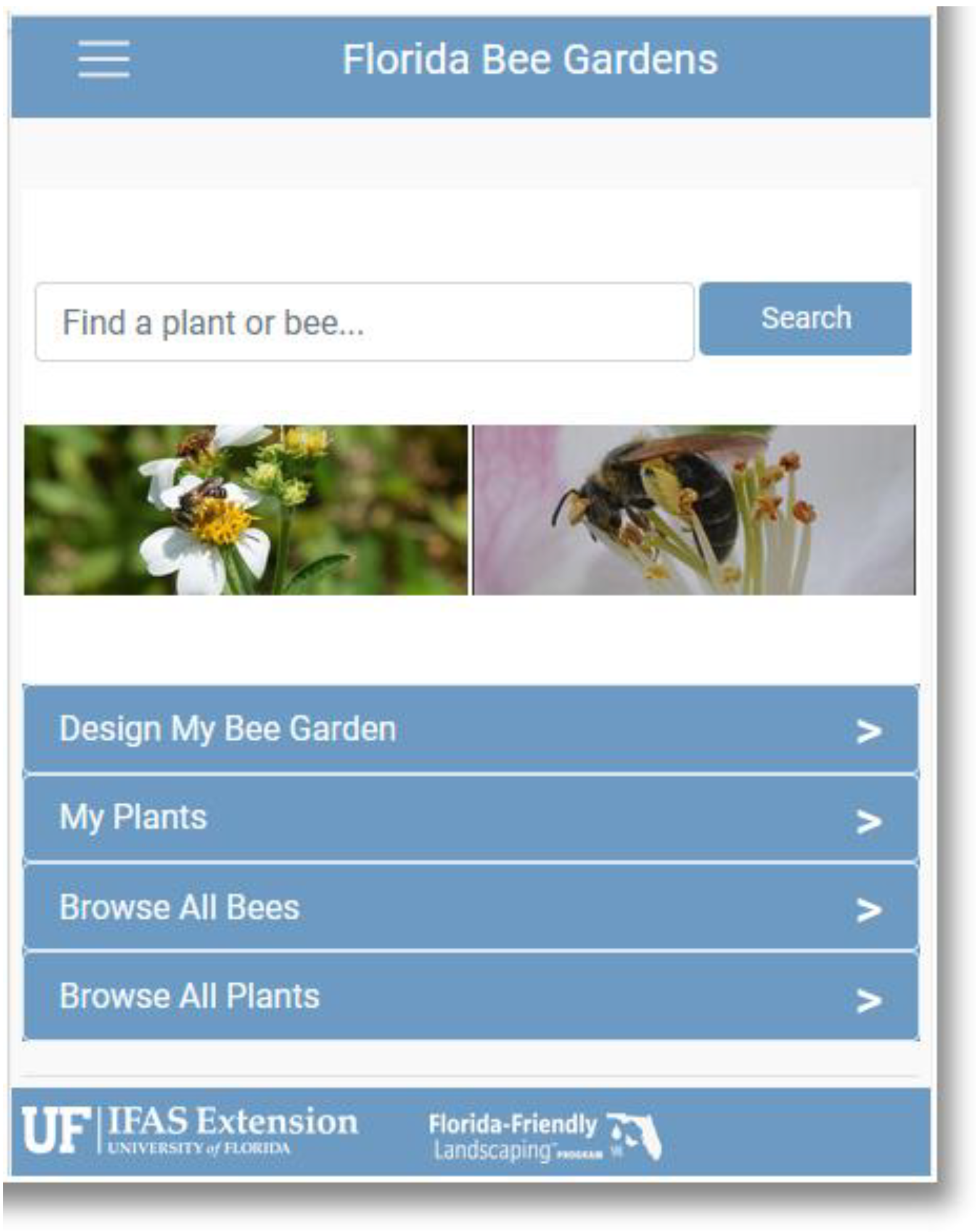Development and Evaluation of a Web Application for Attracting Bees to Your Garden
Abstract
:1. Introduction
2. Materials and Methods
2.1. Design and Development
2.2. Survey Analysis
3. Results and Discussion
Author Contributions
Funding
Institutional Review Board Statement
Data Availability Statement
Acknowledgments
Conflicts of Interest
References
- Mallinger, R.E.; Hobbs, W.; Yasalonis, A.; Knox, G. Attracting Native Bees to Your Florida Landscape. 2019. Available online: https://edis.ifas.ufl.edu/publication/IN1255 (accessed on 7 September 2023).
- Kalaman, H.; Knox, G.W.; Wilson, S.B.; Wilber, W. A master gardener survey: Promoting pollinator-friendly plants through education and outreach. HortTechnology 2020, 30, 163–167. [Google Scholar] [CrossRef]
- National Center for Education Statistics. Postbaccalaureate Enrollment. The Condition of Education. U.S. Department of Education, Institute of Education Sciences. 2023. Available online: https://nces.ed.gov/programs/coe/indicator/chb (accessed on 27 September 2023).
- Kobayashi, K.D. Are there horticulture-related mobile applications for me? HortTechnology 2013, 23, 399–401. [Google Scholar] [CrossRef]
- Lewis, C.; Momol, E.; Wichman, T.; Bossart, J.; Kavalan, C.; Daniels, J.; Wilson, S.B.; Marble, S.C.; Unruh, J.; Wilber, W. Mobile web apps promote Florida-Friendly Landscaping™ (abstr). HortScience 2022, 57, S128. [Google Scholar]
- Wilson, S.B.; Flory, L. FloraGator: A novel, interactive, and online multiple-entry key for identifying plant families. HortTechnology 2012, 22, 410–412. [Google Scholar] [CrossRef]
- Wilson, S.B.; Geneve, R.L.; Davies, F.T.; Sotala, A. PropG- An online application for learning plant propagation glossary terms. HortTechnology 2022, 33, 181–185. [Google Scholar] [CrossRef]
- Florida-Friendly Landscaping™ Program. FFL BeeGardens. University of Florida IFAS Extension. 2023. Available online: https://ffl.ifas.ufl.edu/bees (accessed on 7 September 2023).
- Nunez, G.H.; Anderson, N.O.; Imler, C.S.; Irish, L.; Miller, C.T.; Neves da Silva, M. Gowing beyond zoom- Tips and tricks to teaching horticulture online. HortTechnology 2022, 32, 325–330. [Google Scholar] [CrossRef]
- Craver, J.K.; Williams, K.A. Assessing student learning from an experiential module in a greenhouse management course using hydroponics and recirculating solution culture (abstr). HortTechnology 2014, 24, 610–617. [Google Scholar] [CrossRef]
- Miller, C.T. Using Genially, an interactive online platform in plant propagation for content review. (abstr). HortScience 2021, 56, S148. [Google Scholar]
- Genially. Unlock Your Genius. Design Interactive Content. 2023. Available online: https://genial.ly/ (accessed on 19 December 2023).
- Elmqaddem, N. Augmented reality and virtual reality in education: Myth or reality? Int. J. Emerg. Technol. Learn. 2019, 14, 234–242. [Google Scholar] [CrossRef]

|
| Self-Reported Knowledge Item and Course | Pre-Mean (1–5 Scale) | Post-Mean (1–5 Scale) | Difference ± SE | Significance p ≤ 0.05 |
|---|---|---|---|---|
| Annual and Perennial Gardening, Spring 2021 | ||||
| 1. Ability to identify bee-friendly plants | 2.82 | 4.45 | 1.64 ± 0.31 | 0.004 |
| 2. Ability to identify bee pollinators | 2.55 | 4.00 | 1.45 ± 0.37 | 0.010 |
| 3. Ability to design a bee-friendly garden | 2.55 | 4.55 | 2.00 ± 0.38 | 0.002 |
| Florida Native Landscaping, Spring 2022 | ||||
| 1. Ability to identify bee-friendly plants | 3.55 | 4.82 | 1.27 ± 0.33 | 0.004 |
| 2. Ability to identify bee pollinators | 3.00 | 4.36 | 1.36 ± 0.43 | 0.016 |
| 3. Ability to design a bee-friendly garden | 3.91 | 4.82 | 0.91 ± 0.21 | 0.008 |
| Course | Tested Subject Area | Pre-Course Correct Response (%) | Post-Course Correct Response (%) | Difference (%) ± SE | Significance p ≤ 0.05 |
|---|---|---|---|---|---|
| ORH 4804C | Plant identification | 57.58 | 96.97 | ||
| Pollinator identification | 75.76 | 90.91 | |||
| Plant/pollinator identification | 66.67 | 93.40 | 26.30 ± 6.83 | 0.008 | |
| ORH 3815C | Plant identification | 54.55 | 100 | ||
| Pollinator identification | 69.70 | 100 | |||
| Plant/pollinator identification | 62.12 | 100 | 37.88 ± 7.48 | 0.002 |
Disclaimer/Publisher’s Note: The statements, opinions and data contained in all publications are solely those of the individual author(s) and contributor(s) and not of MDPI and/or the editor(s). MDPI and/or the editor(s) disclaim responsibility for any injury to people or property resulting from any ideas, methods, instructions or products referred to in the content. |
© 2024 by the authors. Licensee MDPI, Basel, Switzerland. This article is an open access article distributed under the terms and conditions of the Creative Commons Attribution (CC BY) license (https://creativecommons.org/licenses/by/4.0/).
Share and Cite
Wilson, S.; Kalaman, H.; Mallinger, R.; Marvin, J.; Lewis, C.; Momol, E. Development and Evaluation of a Web Application for Attracting Bees to Your Garden. Horticulturae 2024, 10, 77. https://doi.org/10.3390/horticulturae10010077
Wilson S, Kalaman H, Mallinger R, Marvin J, Lewis C, Momol E. Development and Evaluation of a Web Application for Attracting Bees to Your Garden. Horticulturae. 2024; 10(1):77. https://doi.org/10.3390/horticulturae10010077
Chicago/Turabian StyleWilson, Sandra, Heather Kalaman, Rachel Mallinger, Jennifer Marvin, Claire Lewis, and Esen Momol. 2024. "Development and Evaluation of a Web Application for Attracting Bees to Your Garden" Horticulturae 10, no. 1: 77. https://doi.org/10.3390/horticulturae10010077






